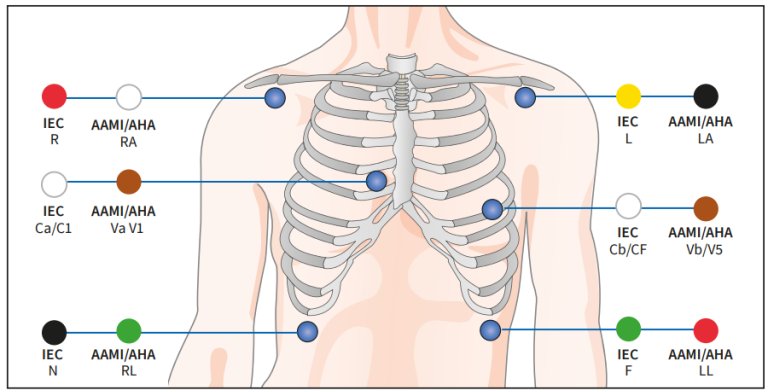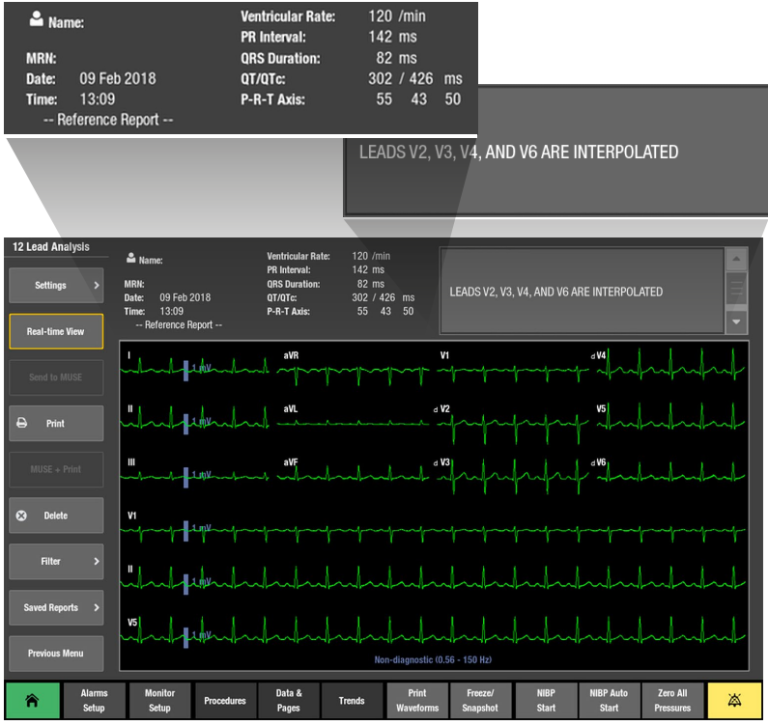Reconstructed 12-lead ECG Monitoring

What is 12RL technology?
Continuous ECG monitoring requires a balance of patient comfort, level of captured monitoring information and clinician workload. High number of electrodes on the patient results in more information being available to the clinician. However, this may result in patient discomfort and clinician workload being compromised.
12-lead ECG monitoring, requiring 10 electrodes, adds value in detecting arrhythmias and acute myocardial ischemia1 . The added value in continuous monitoring might not always be justified, compared to the work required to maintain the set-up. Sometimes it can even be impossible to place 10 electrodes on the patient due to treatment the patient has already received or is due to receive.
The 12RL™ technology provides a full 12-lead view, 12-lead ST monitoring and global QT/QTc interval measurement using a reduced leadset. It means only six electrodes in standard placement (RA, RL, LA, LL, V1 and V5) are required. Other precordial leads are mathematically derived.
The 12RL algorithm detects 8 of the 12 waveforms in the conventional way, and it interpolates the remaining 4. The calculated waveforms are displayed as dV2, dV3, dV4, and dV6. 12RL simulates capabilities for 12 lead monitoring but does not offer full diagnostic capability of 12-lead monitoring ECG. The 12RL should be used for adult patients only.
A standard 12-Lead ECG report can be created with measurements calculated for ventricular rate, PR interval, QRS duration, QT/QTc intervals, and P-R-T axis measurements but the report does not contain interpretations of rhythm, morphology or classification, and it clearly states the interpolated leads.


Leads dV2, dV3, dV4 and dV6 are not directly measured but reconstructed from the information recorded from the other ECG leads. These reconstructed leads are identified on the monitor and in printouts by the letter d (for derived) before the lead name to ensure the clinician can identify the reconstructed waveform tracings.
Accuracy in clinical practice
It has been shown that observations were identical between 12RL and standard 12-lead ECGs for the following: tachycardia, bundle branch and fascicular blocks, left atrial enlargement and the distinction of ventricular tachycardia from supraventricular tachycardia with aberrant conduction2 . The same study also found 99% agreement for prior anterior MI and 95-99% agreement for diagnosis of acute MI.
These results compare favorably with expected accuracy of standard 12-lead ECG, which means 12RL is appropriate for detecting cardiac abnormalities in hospitalized patients.
When to use 12RL
Using 12RL technology is a lot like using a standard 12-lead ECG. 12RL enables 12-lead ECG monitoring on patients when a conventional 12-lead ECG is not practical since some precordial leads may, for example, block the echocardiographic transducer location or be in the way for defibrillator pads. 12RL provides 12-lead ECG monitoring for a larger patient population.
Since 12RL technology uses the standard electrode positions, switching from 12RL ECG to conventional 12-lead ECG just requires adding four electrodes.
Where the current standard of care monitoring may be utilizing five electrodes, adding one more chest electrode would mean that clinicians could obtain the benefits of 12RL technolology
What you need
12RL technology requires a six leadwire set and a corresponding trunk cable or ECG micro-module in order to obtain the ECG signal.
Va and Vb must be properly placed and identified as V1 and V5 in the monitor to enable the 12RL functionality. If this is not the case, the monitor will just show eight leads and not calculate or show dV2, dV3, dV4 and dV6 waveforms.
Why 12RL uses V1 and V5
Leads V1 and V5 compliment the limb leads maximally and the other four precordial leads can be calculated from them with very little error2 .
- Lead V1 is one of the best leads for identification of P-waves, is important for rhythm analysis and provides critical information in distinguishing Ventricular tachycardia (VT) from supraventricular tachycardia (SVT)1,2
- Lead V5 is valuable in detecting MI2 and helps to provide coverage of the anterior and lateral walls of the heart.
On the other hand, there are reasons for not using other precordial leads for 12RL:
- The location for lead V2 conflicts with the preferred location for an echocardiography transducer2
- Leads V3 and V4 may obstruct the placement of defibrillator pads2
Calculating the other four precordial leads from V1 and V5 can be done with very little error.2
ECG reports
With 12RL, the clinician can generate a standard 12-Lead ECG report with measurements calculated by the GE HealthCare 12SL™ ECG analysis program, including:
- Ventricular rate
- PR interval
- QRS duration
- QT/QTc intervals
- Axis
- P-R-T axis measurements
12RL reports do not contain interpretations of morphology or classification. The report states V2, V3, V4 and V6 are interpolated ”to clarify that these leads are lated” to clarify that these leads are not directly acquired

As with all patient monitoring, 12RL ECG needs to be used in conjunction with the patient’s clinical history, symptoms and other diagnostic tests for clinical judgement. 12RL ECG is intended for use in the general adult patient population in a monitoring environment.
References
- Friedman, P.A, MD, The Electrocardiogram at 100 Years: History and Future (2024)
- Drew, B. J., et. al. Comparison of a new reduced lead set ECG with the standard ECG for diagnosing cardiac arrhythmias and myocardial ischemia. Journal of Electrocardiology 35, (Supplement 2002)
Not all products or features are available in all markets. Full product technical specification is available upon request. Contact a GE HealthCare Representative for more information. Please visit www.gehealthcare.com.
Data subject to change.
© 2025 GE HealthCare
12RL and 12SL are trademarks of GE HealthCare. GE is a trademark of General Electric Company used under trademark license.
Reproduction in any form is forbidden without prior written permission from GE HealthCare. Nothing in this material should be used to diagnose or treat any disease or condition. Readers must consult a healthcare professional.
JB32333XX 2/2025








